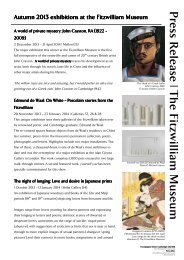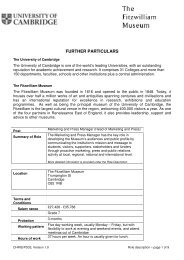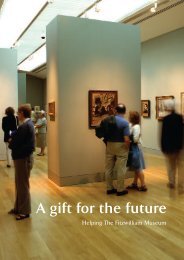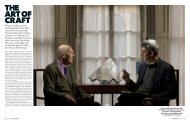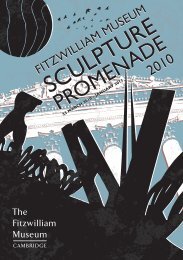Something Different: A pilot study evaluating family outreach ...
Something Different: A pilot study evaluating family outreach ...
Something Different: A pilot study evaluating family outreach ...
You also want an ePaper? Increase the reach of your titles
YUMPU automatically turns print PDFs into web optimized ePapers that Google loves.
<strong>Something</strong> <strong>Different</strong> - Page 8 of 47<br />
by the education officer and carried out by the mothers and children. Linked to the<br />
gallery component of the visit, the craft activities changed for each session. Thus, an<br />
internally consistent theme was maintained for each <strong>outreach</strong> visit.<br />
This <strong>study</strong> included data collection before, after and during two <strong>family</strong> <strong>outreach</strong> visit days: 24<br />
November 2009 and 9 February 2010. The earliest data collection point was one week before<br />
the 24 November visit and the latest point was about two weeks after the 9 February visit.<br />
Methods<br />
Most evaluation research currently being undertaken in museums employs reductionist, oneoff<br />
survey methods that are “incapable of recording the subtle and unmeasurable experiences<br />
which visitors have in a gallery” (Economou, 2004, p. 35). Indeed, Economou (2004, p. 35)<br />
argues that “quantitative-based surveys produced for management which do not relate their<br />
results to the local area [...] might provide a misleading picture when not combined with<br />
interpretative and ethnographic methods (Hooper-Greenhill 1988)”. The methodological goal<br />
of the present <strong>study</strong> was to <strong>pilot</strong> qualitative methods of evaluation research that might provide<br />
the “sort of evidence which can substantiate more general judgments about a series of<br />
projects or a wider programme or initiative” within the context of museum <strong>outreach</strong><br />
(Galloway & Stanley, 2004, p. 127).<br />
The most relevant prior <strong>study</strong> of the impact of community engagement employed a<br />
one-off survey with highly circumscribed response options to pre-formulated statements<br />
(Greenhill et al., 2007). In the present research, the aim was to widen the analytical lens to<br />
explore the perceived value of the <strong>family</strong> <strong>outreach</strong> visits from a visitor-driven perspective. As<br />
such, open-ended qualitative methods were employed, and the research was conducted on a<br />
more longitudinal basis over a four-month period.<br />
Data for this <strong>pilot</strong> <strong>study</strong> was gathered primarily through photographically documented<br />
ethnographic observation and qualitative interviewing. A questionnaire was also <strong>pilot</strong>ed for<br />
the second <strong>outreach</strong> event, yielding additional data. Access to the participants for this <strong>study</strong><br />
was obtained through a gatekeeper who facilitated the loosely organised community centre<br />
meetings attended by the young mothers for their very young (under 3 years old) children to<br />
play in a group setting. The mothers who have been to the Fitzwilliam sessions range in age<br />
from 17-22. One mother has a level two qualification in childcare, which is the highest<br />
education level of the entire group. Most of the mothers have no GCSEs.<br />
All interviews were recorded and professionally transcribed. Fieldnotes were taken<br />
during the ethnographic observations. All the qualitative data was analysed systematically<br />
following standard procedures (for details, see Jensen & Holliman, 2009) and with the<br />
assistance of the computer-aided qualitative data analysis software programme Atlas.ti 5.2.



